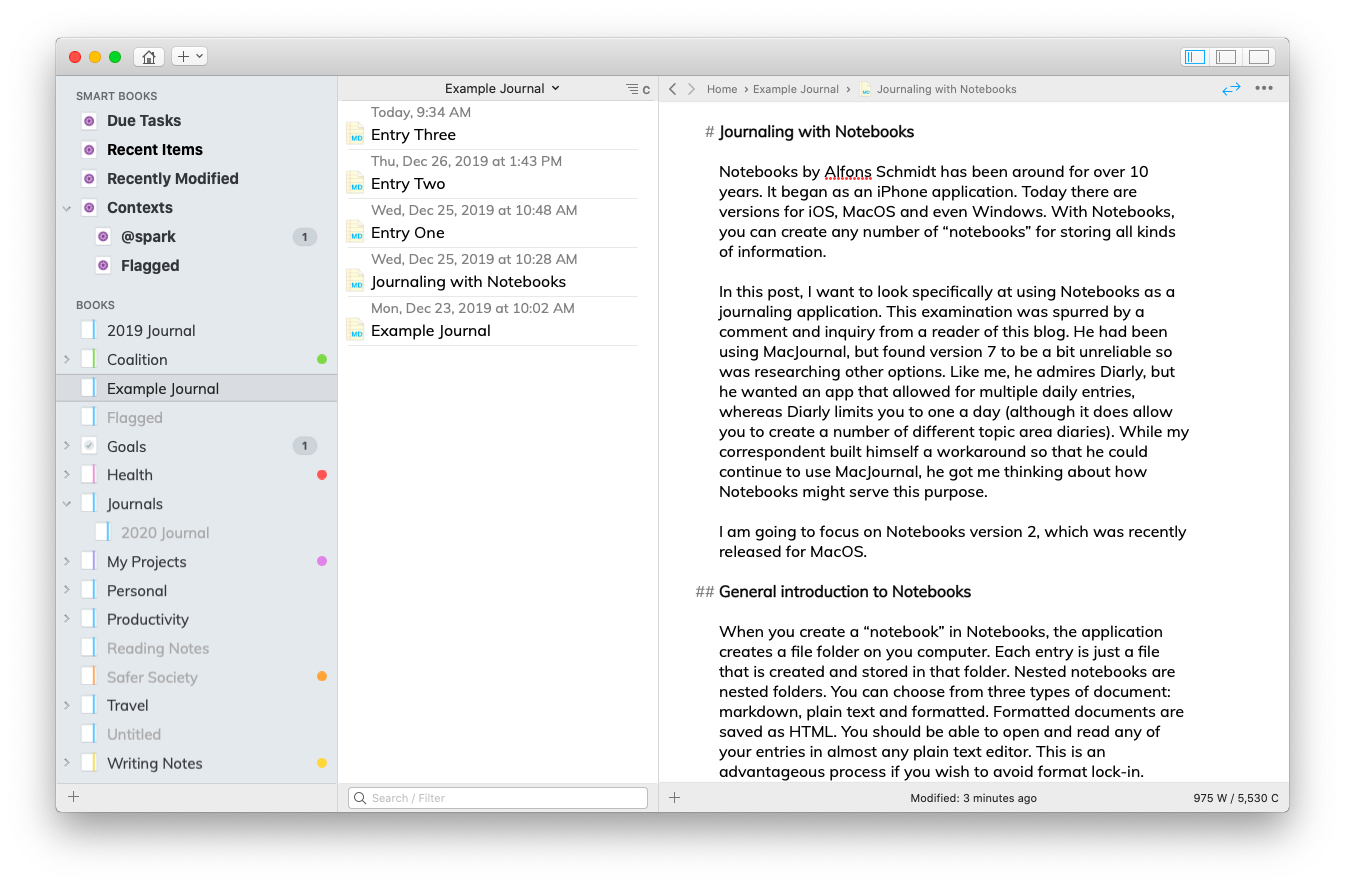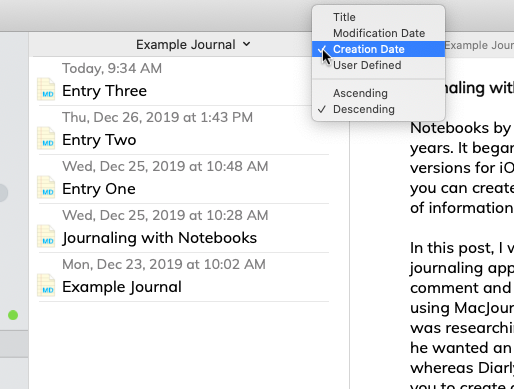
Notebooks by Alfons Schmidt has been around for over 10 years. It began as an iPhone application. Today there are versions for iOS, MacOS and even Windows. With Notebooks, you can create any number of “notebooks” for storing all kinds of information.
Note: See the update at the end of this post.
In this post, I want to look specifically at using Notebooks as a journaling application. This examination was spurred by a comment and inquiry from a reader of this blog. He had been using MacJournal, but found version 7 to be a bit unreliable so was researching other options. Like me, he admires Diarly, but he wanted an app that allowed for multiple daily entries, whereas Diarly limits you to one a day (although it does allow you to create a number of different topic area diaries). While my correspondent built himself a workaround so that he could continue to use MacJournal, he got me thinking about how Notebooks might serve this purpose.
I am going to focus on Notebooks version 2, which was recently released for MacOS.
General introduction to Notebooks
When you create a “notebook” in Notebooks, the application creates a file folder on you computer. Each entry is just a file that is created and stored in that folder. Nested notebooks are nested folders. You can choose from three types of document: markdown, plain text and formatted. Formatted documents are saved as HTML. You should be able to open and read any of your entries in almost any plain text editor. This is an advantageous process if you wish to avoid format lock-in.
If you want to use your entries on multiple devices, you need to save your files on a service like Dropbox. I’ve been doing so and have had no sync issues as of yet.
Notebooks is intended to be used the way you might use Evernote, as a repository for all your information, so you can store many types of files in your notebooks, including Word formatted documents, PDFs, images and more. You can also set a notebook to display entries as tasks, so you can add due dates. These are not necessarily features you need for journaling, but would be appealing if you want to integrate your notes and your journal in one application.
Notebooks has something called “Smart” books. These are filtered views that show you subsets of your data across all your notebooks. However, they appear static. That is, you can’t edit them or create new ones. You are limited to the default smart books:
- Due Tasks
- Recent Items
- Recently Modified
- Contexts (quasi tags)
Another feature that I like is the editor uses typewriter mode, so the line you’re working on is always centered vertically in the editor window. What is odd about this implementation is that there is apparently no way to turn it off, though I may simply have not yet found it.
My Notebooks journal
The first issue to be aware of, and it will affect how I set up my journal, is that Notebooks has a search function limited to one “notebook” at a time. This means that I will use a single notebook per yearly journal so I can efficiently search my content.

I then set the entry list to sort my entries by date created. This does two things. First, of course, it puts the entries in proper order. But more importantly it displays the date and time the entry was created. This is how you can easily create multiple entries per day and track them in the note list.
Personally, I prefer one entry per day. I can easily break them into areas with markdown headers, and I can add time stamps as needed.

Reasons to use Notebooks for your journal
Here is a quick list of reasons you might consider Notebooks for journaling:
- A rich markdown writing environment
- Renders handsome documents in markdown
- Access your journal on all your Apple devices (there is also a Windows edition, but I have not tried it recently)
- All-in-one note-taking application
- No subscription
Reasons you may want to look elsewhere
This is a quick list of reasons another application might suit you better:
- Limited tagging features
- Search limited to a notebook at a time
- No saved searches or filters
Notebooks over Bear
Bear is another note-taking application that is well thought out and has proven to be reliable. I briefly thought it might be a contender as my journaling app, but after comparing it to Notebooks, I’m convinced Notebooks is a better choice. There are two reasons:
- To keep your journal separate from the rest of your notes, you need to use a tag. This isn’t a deal-killer, by any means, but it just feels to me as sloppier than being able to slot your journal entries into a “Journal” notebook.
- This, to me, is the main reason to choose Notebooks over Bear. There appears to be no method of displaying the date and time in the note list in Bear. You can sort your entries by creation or modification date, but you can’t see the date and time it was created. You can, of course, use the date and time as the title of your entries, but that’s not something I want to be forced into doing.
Certainly, if you already use Bear and love it, you can overcome or ignore these deficiencies. At this point, I don’t want to.
The bottom line
Notebooks has a lot of features for note-taking and note-keeping that I haven’t mentioned because I don’t believe they pertain directly to using the application as a journal. I won’t pretend this isn’t a thoroughly subjective review; however, I hope I’ve provided enough information to help you decide if Notebooks is worth trying. It does have a free trial period.
While applications like Bear and Diarly provide a live preview of the rendered markdown as you type, I find I prefer to work in the plain text environment and then switch to view mode when I am done writing. You may feel the exact opposite.
I started out using Notebooks as a temporary exercise to see how it would work as a journal, but I’ve enjoyed journaling in the application enough that I’m going to continue to do so.
Update
After seeing this post, Notebooks developer, Alfons Schmidt, proivded a few welcome corrections:
– in Notebooks you can search all books at once; while the default is the hierarchy below the current book, you can check the box “search all books” to expand the search scope.
– what may be surprising in this context: as you start typing in the search field, you actually filter the currently displayed list; when you type return you trigger a search. That is the moment when the above mentioned box appears.
– Live preview of rendered Markdown is available in Notebooks as well: you can open the (same) document in a separate window; while you edit the text in one window, the rendered Markdown will update in the other. So users are not “forced” to use the preview, but they can if they want 😉
One thought on “Using Notebooks as a daily journal”